Contraceptive Jewelry Could Offer a New Family Planning Approach
Mar 27, 2019 — Atlanta, GA
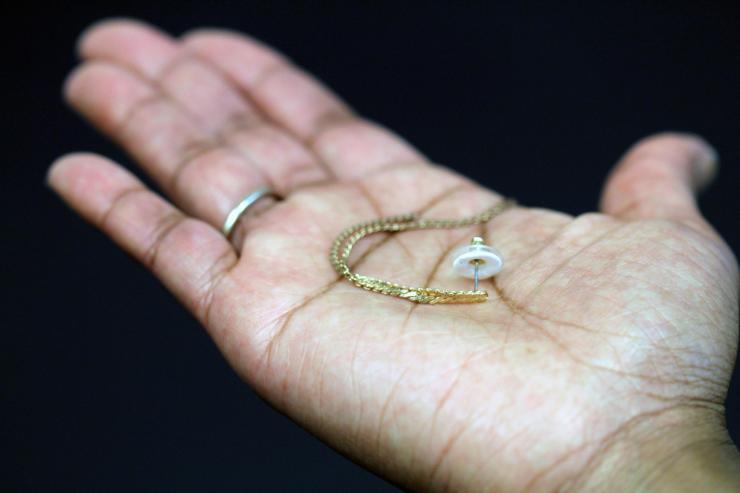
An earring is shown paired with a transdermal patch backing. The white ring is the patch containing the contraceptive hormone. (Credit: Mark Prausnitz, Georgia Tech)
Family planning for women might one day be as simple as putting on an earring.
A report published recently in the Journal of Controlled Release describes a technique for administering contraceptive hormones through special backings on jewelry such as earrings, wristwatches, rings or necklaces. The contraceptive hormones are contained in patches applied to portions of the jewelry in contact with the skin, allowing the drugs to be absorbed into the body.
Initial testing suggests the contraceptive jewelry may deliver sufficient amounts of hormone to provide contraception, though no human testing has been done yet. A goal for the new technique is to improve user compliance with drug regimens that require regular dosages. Beyond contraceptives, the jewelry-based technique might also be used for delivering other drugs through the skin.
“The more contraceptive options that are available, the more likely it is that the needs of individual women can be met,” said Mark Prausnitz, a Regents Professor and the J. Erskine Love Jr. chair in the School of Chemical and Biomolecular Engineering at the Georgia Institute of Technology. “Because putting on jewelry may already be part of a woman’s daily routine, this technique may facilitate compliance with the drug regimen. This technique could more effectively empower some women to prevent unintended pregnancies.”
This proof-of-concept research was supported by the U.S. Agency for International Development (USAID) under a subcontract funded by FHI 360.
Contraceptive jewelry adapts transdermal patch technology that is already used to administer drugs that prevent motion sickness, support smoking cessation, and control the symptoms of menopause, but have never been incorporated into jewelry before. Contraceptive patches are also already available, but Prausnitz believes pairing them with jewelry may prove attractive to some women – and allow more discreet use of the drug delivery technology.
“There is a lot of experience with making and using conventional transdermal patches,” he said. “We are taking this established technology, making the patch smaller and using jewelry to help apply it. We think that earring patches can expand the scope of transdermal patches to provide additional impact.”
Postdoctoral Fellow Mohammad Mofidfar, Senior Research Scientist Laura O’Farrell and Prausnitz tested the concept on animal models, first on ears from pigs. Test patches mounted on earring backs and containing the hormone levonorgestrel were also applied to the skin of hairless rats. To simulate removal of the earrings during sleep, the researchers applied the patches for 16 hours, then removed them for eight hours. Testing suggested that even though levels dropped while the earrings were removed, the patch could produce necessary amounts of the hormone in the bloodstream.
The earring patch tested by the researchers consisted of three layers. One layer is impermeable and includes an adhesive to hold it onto an earring back, the underside of a wristwatch or the inside surface of a necklace or ring. A middle layer of the patch contains the contraceptive drug in solid form. The outer layer is a skin adhesive to help stick to skin so the hormone can be transferred. Once in the skin, the drug can move into the bloodstream and circulate through the body.
If the technique ultimately is used for contraception in humans, the earring back would need to be changed periodically, likely on a weekly basis.
The contraceptive jewelry was originally designed for use in developing countries where access to health care services may limit access to long-acting contraceptives such as injectables, implants and IUDs. However, Prausnitz says the technology may be attractive beyond that initial audience. “We think contraceptive jewelry could be appealing and helpful to women all around the world,” said Prausnitz.
The researchers tested patches adhered to earring backs, about one square centimeter in area, and placed them tightly on the skin of the test animals. Earring backs and watches may be most useful for administering drugs because they remain in close contact with the skin to allow drug transfer. The dose delivered by a patch is generally proportional to the area of skin contact.
“The advantage of incorporating contraceptive hormone into a universal earring back is that it can be paired with many different earrings,” Prausnitz noted. “A woman could acquire these drug-loaded earring backs and then use them with various earrings she might want to wear.”
Though transdermal drug-delivery patches have been available since 1979, testing would be required to determine whether the earring patch is safe and effective. In addition, research would be required to determine whether the concept would be attractive to women in different cultures.
“We need to understand not only the effectiveness and economics of contraceptive jewelry, but also the social and personal factors that come into play for women all around the world,” Prausnitz said. “We would have to make sure that this contraceptive jewelry concept is something that women would actually want and use.”
The technique could potentially be used to deliver other pharmaceuticals, though it would only be suitable for skin-permeable drugs that require administration of quantities small enough to fit into the patches.
“We think there are uses beyond contraceptive hormones, but there will always be a limitation that the drug has to be effective with a low enough dose to fit into the limited space in the patch,” Prausnitz said. “It also should be a drug that would benefit from continuous delivery from a patch and that is administered to a patient population interested in using pharmaceutical jewelry.”
The earring patch is designed to add another contraceptive option for women. “Pharmaceutical jewelry introduces a novel delivery method that may make taking contraceptives more appealing,” he added. “Making it more appealing should make it easier to remember to use it.”
This work was made possible by the generous support of the American people through the U.S. Agency for International Development (USAID). The contents are the responsibility of the authors and do not necessarily reflect the views of FHI 360, USAID or the United States Government. This research was supported by USAID cooperative agreement AID-OAA-15-00045 under a subcontract funded by FHI 360 as a proof-of-concept study (https://www.fhi360.org/projects/envision-fp).
CITATION: Mohammad Mofidfar, Laura O’Farrell and Mark R. Prausnitz, “Pharmaceutical jewelry: Earring patch for transdermal delivery of contraceptive hormone,” (Journal of Controlled Release, 2019) https://doi.org/10.1016/j.jconrel.2019.03.011
Research News
Georgia Institute of Technology
177 North Avenue
Atlanta, Georgia 30332-0181 USA
Media Relations Contact: John Toon (404-894-6986) (jtoon@gatech.edu)
Writer: John Toon
Stay informed about the latest Georgia Tech research. Subscribe to our free monthly e-newsletter at www.rh.gatech.edu/subscribe
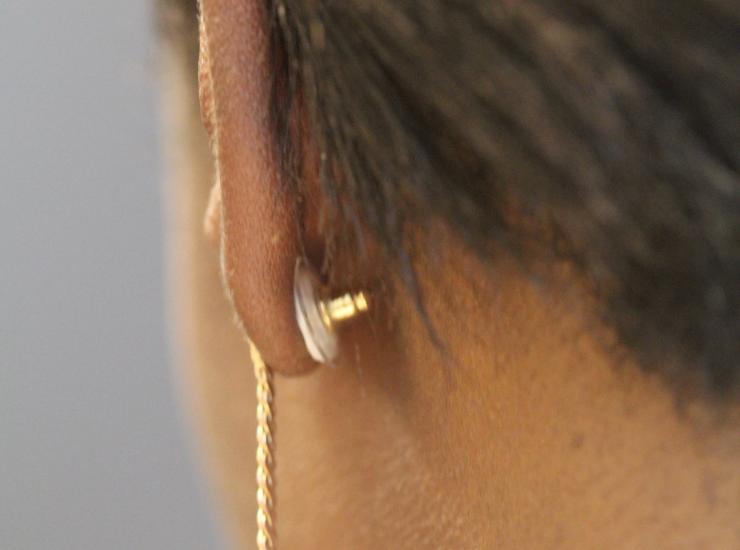
A contraceptive earring patch is shown as it would be worn on a woman’s ear. The white contraceptive patch can be seen attached to the earring back and adhered to the back of the ear. (Credit: Mark Prausnitz, Georgia Tech)
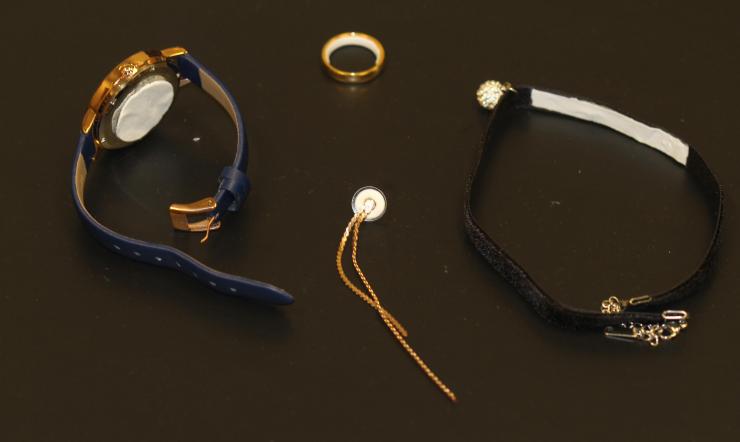
Image shows potential contraceptive jewelry, in clockwise order, a pharmaceutical watch, ring, choker necklace and earring. In each case, a white contraceptive patch material is applied to a part of the jewelry that would be in contact with the skin. (Credit: Mark Prausnitz, Georgia Tech)
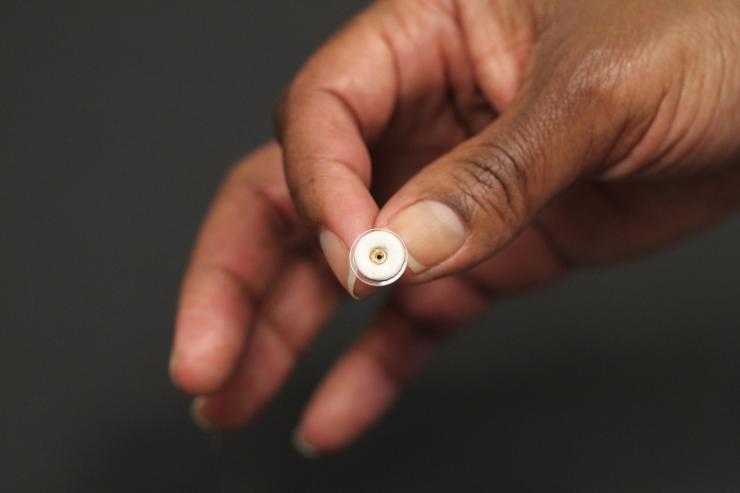
This photograph shows an earring patch (white) that can deliver contraceptive hormone while being worn on an earring back. The size of the patch is about one square centimeter. (Credit: Mark Prausnitz, Georgia Tech)
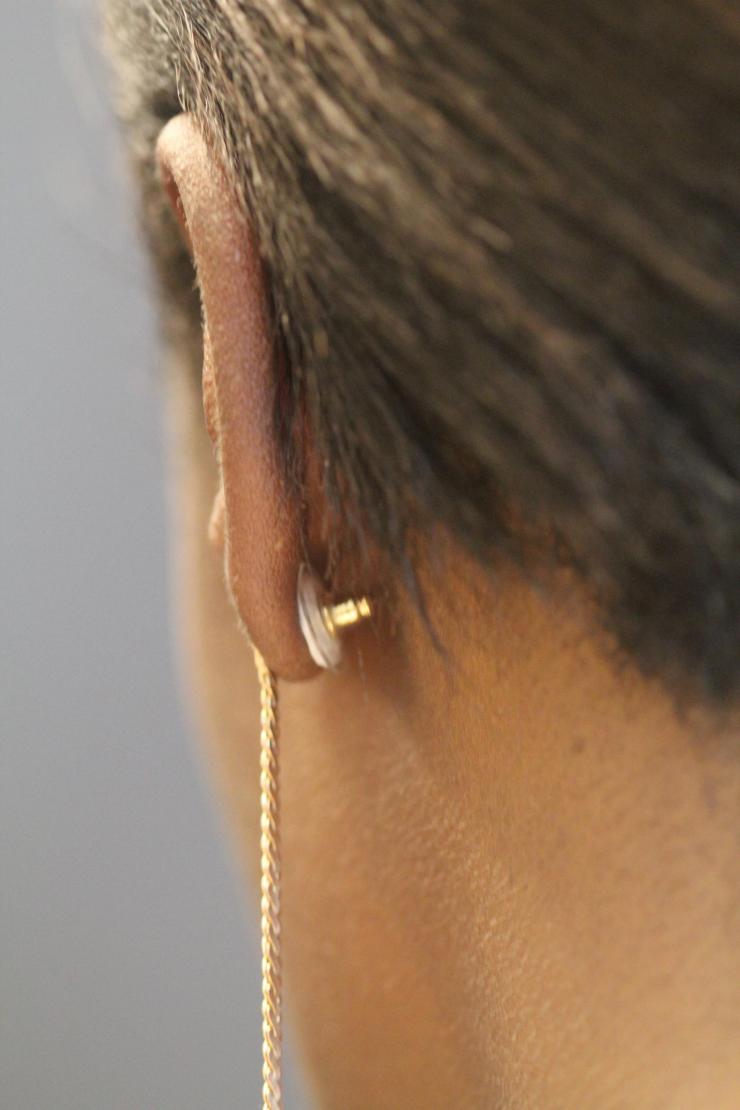
A contraceptive earring patch is shown as it would be worn on a woman’s ear. The white contraceptive patch can be seen attached to the earring back and adhered to the back of the ear. (Credit: Mark Prausnitz, Georgia Tech)
John Toon
Research News
(404) 894-6986




